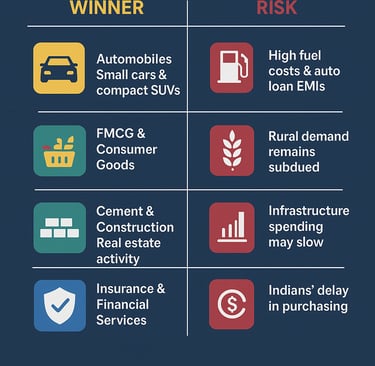GST Reform 2025: Will It Really Spark a Market Rally or Just Hype?
India’s long-awaited GST Reform 2025 has finally arrived. The government has simplified the tax structure, reduced rates on essentials, and promised to boost consumer demand by ₹2.4 lakh crore. Stock markets have already cheered the move, but the big question remains: Is this the start of a genuine bull run, or just short-term hype?
RAVINDRA PRAJAPATI
8/19/20252 min read


What Changed in GST 2.0?
The four-tier GST system has been simplified into two slabs: 5% and 18%.
The 28% tax slab is almost gone—only “sin goods” like tobacco, liquor, and luxury items remain taxed heavily (~40%).
Small cars move from 28% to 18%, a major relief for middle-class buyers.
Insurance premiums (life & health) may see GST fall to as low as 0–5%.
Everyday essentials like FMCG goods, juices, butter, packaged food now fall under lower rates.
👉 In short: Consumption gets cheaper.
Sector-by-Sector Impact
1. Automobiles
Winner: Small cars & compact SUVs.
Companies like Maruti Suzuki, Tata Motors, Hyundai benefit from increased affordability.
Risk: High fuel costs & auto loan EMIs could limit demand.
2. FMCG & Consumer Goods
Winner: Packaged food, personal care, household items.
Stocks like HUL, Nestlé, Dabur, ITC already see positive momentum.
Question: Will rural demand actually rebound strongly, or stay sluggish?
3. Cement & Construction
Winner: Cement giants such as UltraTech, Shree Cement, ACC.
Lower taxes = cheaper construction = more real estate activity.
Caveat: If government revenue falls, infra spending may slow down.
4. Insurance & Financial Services
Winner: Life & health insurers like HDFC Life, SBI Life, ICICI Prudential.
Cheaper premiums could drive more policy uptake.
Risk: Indians often delay insurance decisions despite affordability.
5. Broader Markets
Consumption-driven sectors expected to rally.
Cyclical plays (retail, real estate, discretionary spending) may gain.
Export-heavy sectors (IT, pharma) less affected directly.
What Analysts Are Saying
Jefferies & Morgan Stanley estimate GST reform could boost GDP by 0.5–0.6%.
Market rally post-announcement shows positive sentiment.
But experts caution: Fiscal deficit pressure could rise if tax collections fall.
The Big Question(⚖️): Rally or Just Hype?
Why it could spark a real rally:
More money in consumer pockets → higher spending.
Stronger demand for autos, housing, FMCG.
Long-term boost to insurance penetration.
Why it might just be hype:
Festive season demand may give only a short-term push.
Rising fuel prices & inflation could offset benefits.
Government finances may strain if collections fall, limiting infra push.
Final Analysis
The GST Reform 2025 is undoubtedly a pro-consumption move, with autos, FMCG, cement, and insurance as the biggest winners. Short-term, stock markets may continue to rally. But whether this turns into a sustained bull market depends on one thing: Will Indian consumers actually spend more?
So, while the headlines scream “Diwali Gift,” investors must ask: Is GST 2.0 a long-term growth engine—or just a festive sugar rush for the markets?
RAVINDRA PRAJAPATI, Not a sebi registered
FOLLOW Us
ravindra.prajapati1122@gmail.com
+91 9795187745
© 2025. PiPiFinTech All rights reserved.
Contact Us
ABOUT Us
Our mission is to empower you to maximize every single penny and best solution for wealth generation and management for every mature age group.
Product TOPICS
Digital E-Wealth Platform
Mutual Funds
Education Planning
Insurance
FD and Bonds
Retirement Planning
Wealth Creation
(Disclaimers : Mutual Fund investments are subject to market risks, please read scheme related documents carefully.)
